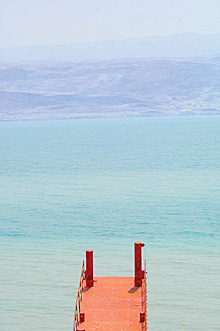Autumn 2007: Prelude

Kay Hinton
By Mary J. Loftus
The Dead Sea is slowly disappearing.
Yes, just like the Alaskan glaciers, even ancient, larger-than-life landmarks have their beginnings and their endings. This massive salt lake between the West Bank and Israel in the Jordan Rift Valley may someday dry up.
Pooled at the lowest spot on earth, the lake is about thirty-eight miles long and eleven miles wide, and nine times saltier than the ocean. The Dead Sea’s levels are dropping every year due to evaporation, droughts, and the use of its sole source, the Jordan River, to water agricultural fields.
For thousands of years, visitors have come to immerse themselves in its waters.
As I stood knee-deep in the lake of salt, sinking my toes into the dark mud at its bottom and feeling the slightly oily texture of the water, I was struck most by its tranquility. Varying hues of blue-green merged with the desert mountains and cloudless sky to create a cerulean palette, a place that felt as calming as a deep breath.
Related Story
Beyond the Wall: Despite disheartening divisions in the Holy Land, the hope for peace endures
For our Emory group—on a journey arranged by Dean of the Chapel and Religious Life Susan Henry-Crowe 76T to Jordan, Israel, and the Palestinian territories—the Dead Sea proved to be a baptism of sorts.
We were entering a region that is simultaneously united and divided by its history, hoping to call attention to peace work being carried out by brave people on all sides of the conflict.
Emotions run strong in this part of the world, alongside firmly held territorial and religious beliefs. These arid lands boast ancient holy sites considered by many in the Abrahamic religions—Jews, Christians, and Muslims—to be among the most sacred spots on Earth.
Of the days that followed—wending our way through Jerusalem, the West Bank, and the Negev Desert—each interaction was transformative for me:
- communicating through sign language with a girl my daughter’s age in a Palestinian refugee camp in Bethlehem
- savoring honey cake and sage tea on a scenic hillside in the West Bank, where Daoud Nassar struggles to hold on to his family’s land
- watching Hasidic Jews, in dark suits and with side curls, murmur prayers at the Western Wall while touching their foreheads to the worn stones
- winding through the labyrinth of Old City Jerusalem with its marketplace stalls, holy sites, visiting nuns, and European backpackers
- meeting two committed young intellectuals—one from the Knesset and one from the Palestinian Authority—who spoke passionately about their work for their respective governments and people, but who may never get the opportunity to speak directly to each other
- hearing Emory Professor Shalom Goldman read Allen Ginsberg poetry aloud at a gridlocked coffee bar in the commercial district of Jerusalem
- listening to Emory alumni, both Palestinian and Israeli, speak about their loyalty to their families, love for their homeland, despair over outbursts of violence that threaten peace, and stubborn hope for the future.
Emory is not sitting in quiet contemplation, but reaching out into the world—through the good works of its far-flung alumni, visiting scholars, health initiatives, global research, and programs like Journeys, which take Emory groups to areas of the world with histories of conflict.
But we don’t always have to travel the globe to discover such rich exchange. EM Editor Paige Parvin 96G visited the Good Samaritan Center, a free clinic in the rural mountain community of Pickens County, Georgia, founded five years ago by Professor Emeritus John Spitznagel and alumnus Al Hallum 58C 62M. “Everybody here is here because we want to help, to give something back,” Hallum said. “We are able to do something of value for these people. It gives them a little better hold on some quality of life.”
There are internal worlds to explore as well, as Alec Young 03Ox 05C discovered in the correspondence between Georgia writer Flannery O’Connor and Atlanta file clerk Betty Hester in the 1950s.
Hester donated the letters to Emory in 1987 on the condition that they remain sealed for two decades. Opened this year to the public’s eye, these posts, exchanged almost weekly between O’Connor and Hester, capture raw emotions and wry humor. “My avocation is raising peacocks,” O’Connor wrote in one letter, “something that requires everything of the peacock and nothing of me, so time is always at hand.” The letters have become the lasting framework of their extraordinary friendship.
Understanding comes with immersion: listening to lost words, touching the salty water, absorbing the whole story.